Table of Contents
THE LURE OF REALLY BIG NUMBERS
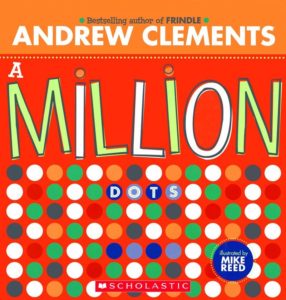 |
Andrew Clements’s picture-book A Million Dots (Simon & Schuster Children’s Publishing, 2006) indeed contains one million dots, along with a lot of catchy factoids to help readers visualize enormous numerical quantities. Readers learn, for example, that there are 525,600 minutes from one birthday to the next and that when the cow jumped over the moon, she soared upward 238,857 miles. For ages 4-8. |
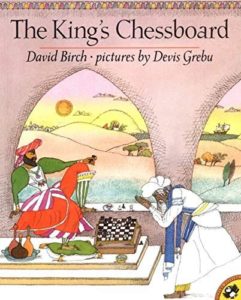 |
In David Birch’s picture book The King’s Chessboard (Puffin, 1993), rice is used to teach simultaneous lessons in morals and the mathematics of big numbers. A proud and pushy king insists on giving his counselor, who doesn’t want it, a reward; the pestered counselor finally asks for a grain of rice, the amount to be doubled each day for as many days as there are squares (64) on the king’s chessboard. The king thinks this is a fine joke and sends one grain, then two, then four – but as the days pass and the doubling continues, soon amounting to humongous quantities of rice, he realizes that he has made a fatal mistake. |
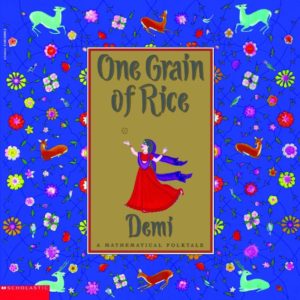 |
In Demi’s version of the story, One Grain of Rice: A Mathematical Folktale (Scholastic, 1997), gorgeously illustrated with touches of gold, young Rani outsmarts a selfish raja and saves her hungry village with her rice-and-chessboard request. Here the rice is delivered by animals: birds, leopards, tigers, a goat pulling a cart, and – impressively, on day 30 – a fold-out page of 256 rice-toting elephants. |
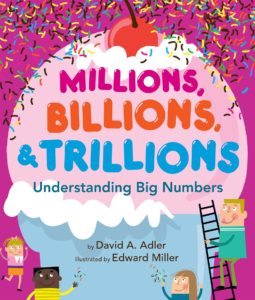 |
David A. Adler’s Millions, Billions, & Trillions (Holiday, 2014) introduces big numbers with lots of cool examples. (A quarter cup of sugar contains about 1 million sugar granules.) For ages 6-9. |
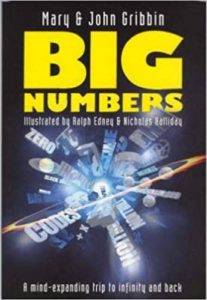 |
Big Numbers by Mary and John Gribbin (Wizard Books, 2005), subtitled “A Mind-Expanding Trip to Infinity and Back,” traces the history of big numbers and shows how big numbers are used in a range of scientific disciplines, such as astronomy, biology, and geology. For ages 9-12. |
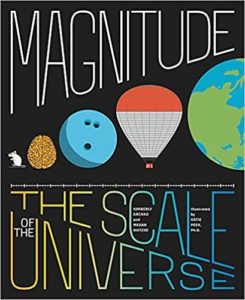 |
Megan Watzke and Kimberly Arcand’s Magnitude: The Scale of the Universe (Black Dog & Leventhal, 2017) includes comparisons of distance, area, volume, mass, and speed. A fascinating journey through big and small numbers. For ages 12 and up. |
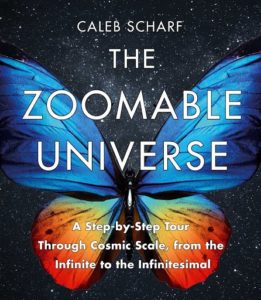 |
Caleb Scharf’s The Zoomable Universe (Scientific American, 2017) is an epic tour from the limits of the observable universe to the inside of the atom, packed with photos and infographics. For ages 12 and up.
|
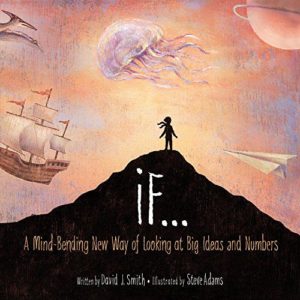 |
David J. Smith’s iF… (Kids Can Press, 2014), subtitled “A Mind-Bending New Way of Looking at Big Ideas and Numbers,” is a terrific overview of measurement. Smith has come up with clever ways of scaling large numbers and concepts down to readily graspable form. (If the Milky Way Galaxy were the size of a dinner plate, our solar system would be smaller than a speck of dust.) Fascinating for all. |
 |
The Megapenny Project demonstrates big numbers with stacks of pennies, from a piddling pile of sixteen to a foot-square cube of 50,000 to a towering structure of a million and more. |
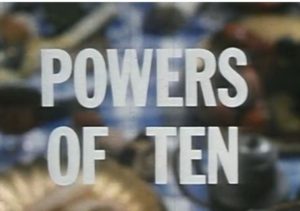 |
Powers of Ten: About the Relative Size of Things in the Universe is a film by Charles and Ray Eames in which viewers journey from the outer limits of the universe to the subatomic quark in 42 ten-fold steps. It’s a wonderful progression in color photographs, beginning with two picnickers in a park and moving outward through city, continent, planet, solar system, and galaxy; then inward through skin, cells, DNA, atoms, and subatomic particles. Fascinating for all ages. |
| Experiment with an interactive online version of Powers of Ten. | |
| A Question of Scale is a clickable illustrated tour of the universe (“from quarks to quasars”) in powers of ten. | |
| Cosmic View, based on Kees Boeke’s classic 1957 books, travels to the ends of the universe and to the innards of the atom, beginning with a little girl with a cat on her lap. Includes detailed explanations. (Click on Powers of Ten.) | |
| The View From the Back of the Envelope is a creative and multifaceted website on big numbers, featuring – among much else – a page displaying a million dots; a big-number Pinocchio estimation game; a guide for scaling the universe to a desktop; explanations of exponential notation; a list of “Powers of Ten” scales; and a demonstration of the scope of big numbers using grains of salt. | |
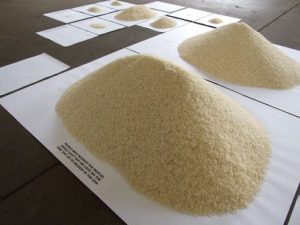 |
The Stan’s Café Theatre Company’s installation exhibit Of All the People in All the World uses piles of rice to represent a host of human statistics. One person is represented by one grain of rice; the entire population of the world – that is, some six and a half billion grains of rice – by a 104-ton rice mountain. Other piles of rice variously represent the population of the United States, the number of Americans who are millionaires, the number of people worldwide who play the computer game “World of Warcraft,” the number of people killed in the Holocaust, the number of people in an average year who go on a pilgrimage to Mecca. (And much more.) A fascinating exercise in statistics, a startling social commentary, and a powerful demonstration of big (and small) numbers. |
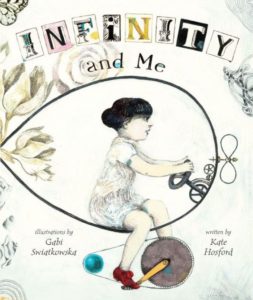 |
How to even think about something as big as infinity? Kate Hosford’s Infinity and Me (Carolrhoda, 2012) is a fascinating and thoughtful approach to the incredibly large. For ages 5-10. |
